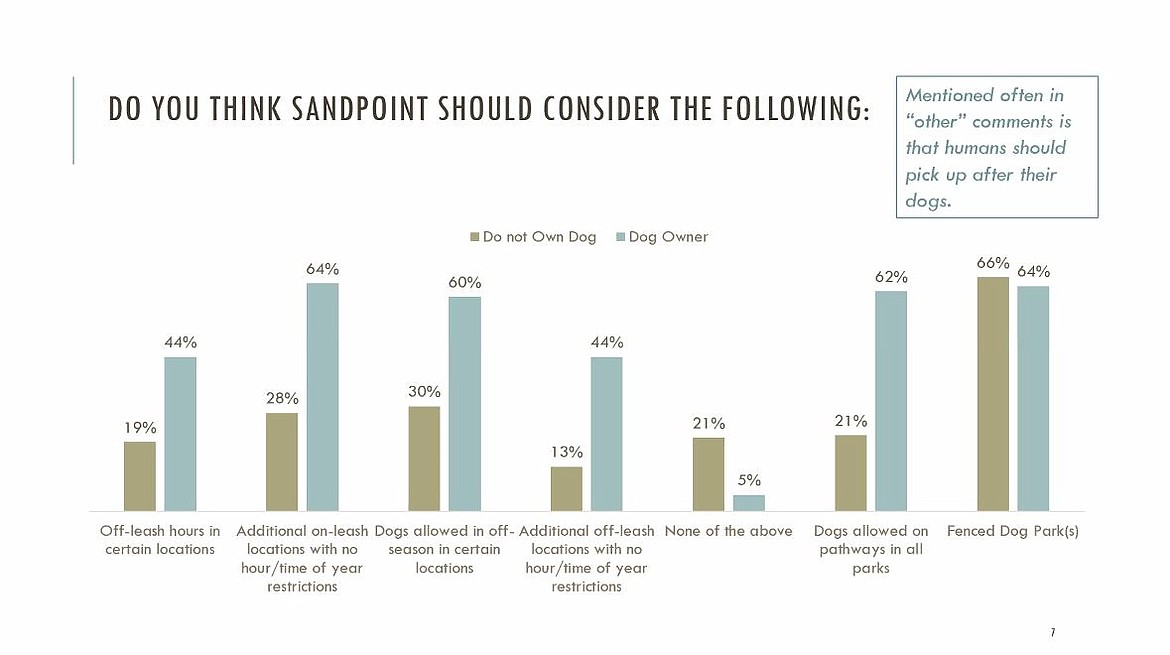Council approves city code amendments, hears considers changes to dog policy
Council members approved amendments to city code and heard a presentation on the Draft Multimodal Transportation Master Plan and a survey on dog-friendly areas in Sandpoint at their meeting Wednesday.
The code changes include limiting the construction of drains, gutters and curbs with each new building permit to avoid “patchworks” of construction and unintended consequences, such as water on adjacent properties, standing water and impractical infrastructure investments.
Another change to code will make it so accessory dwelling units are no longer required to have a separate stormwater management plan, but provide and maintain erosion prevention measures in accordance with best management practices established by the city.
The amendments also change the maximum size for an ADU from 650 square feet to 900.
Lastly, the amendments clarify rules regarding building variance, and state that under no circumstances will the city issue variances after the issuance of a building permit.
Council members also heard a presentation by City Administrator Jennifer Stapleton on a recent survey regarding dog-friendly areas in Sandpoint.
The survey was one of the most successful, Stapleton said, with almost 700 respondents. Many were dog owners and lived within Sandpoint city limits.
The majority of respondents, and particularly dog owners, either feel somewhere in the middle or felt the city’s current rules for parks and paths are too restrictive.
Currently, dogs are not allowed at city parks except for Humbird Mill, Hickory, and Lakeview parks. Dogs are also required to be on leash.
The majority of dog owners said they walked their dogs around their neighborhood with the most popular location in the city being the Sand Creek Trail followed by Humbird Mill Park and the Ponderay Bay Trail.
Residents also brought up the challenge of finding places to exercise their dog off-leash, and the majority said they would travel over a mile to exercise their dog.
Based on the survey, staff created a list of recommendations for dog policies. Those included allowing leashed dogs at Travers and Centennial parks, where paths are maintained throughout the winter, in part to accommodate for elders walking their dogs.
It also included the consideration of a dog park at Lakeview Park and seasonally allowing leashed dogs at City Beach on paved paths and in the grass from Sept. 15 to April 15.
Another recommendation was to allow dogs to go off-leash at the Mickinnick Trail, where owners frequently let their dogs off-leash anyway, and the city has not experienced problems.
Also that night, council members heard a presentation from Public Works Director Amanda Wilson on part two of the city’s Draft Multimodal Transportation Master Plan.
The plan, which is now available to view in full on the city’s website, includes plans for pedestrian priority networks, bicycle priority networks, updated truck routes and 55 capital projects, including the Baldy Mountain Road extension.
The pedestrian and bicycle networks will not be implemented all at once, Wilson said, but the plan outlines places identified as ideal for those networks. Prioritizing which arterial connections come first will be the next step.
In some cases, the pedestrian networks would first be built on one side of the road and the sidewalk on the other side would be added later. The plans were developed based on a combination of traffic studies and community input.
“It’s really expanding the [pedestrian] network and solidifying where we’re going to invest our priorities,” she said.
Rebecca Holland, a cyclist and business owner in Sandpoint, said she had concerns about the bike route, specifically regarding the intersection at First Avenue, Church Street and Bridge Street.
The intersection is unsafe for cyclists, she said, many of which are children riding to City Beach.
“When you come into the downtown core, that needs to be treated differently. They need to have a separate lane. And that means giving up some parking,” she said.
Of the capital improvement projects, the 55 in the plan include all other previously identified capital projects, Wilson said.
The projects are split into three timeframes. Total project costs in the zero to five years range are estimated to be $21,090,000, with six to 10 years at $48,620,000 and 11 to 20 years at $25,750,000.
The next steps will be choosing which parts of the plan to prioritize, and start work on preliminary designs.
Some especially large projects, such as the Baldy Mountain Road extension, will need grant funding.
“It would be to our advantage to get some preliminary designs,” she said. “It makes our grant application a lot stronger … prioritizing all of our wants and needs is going to be difficult, but I’m really excited to have our list to start that conversation.”

